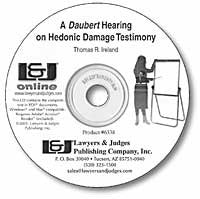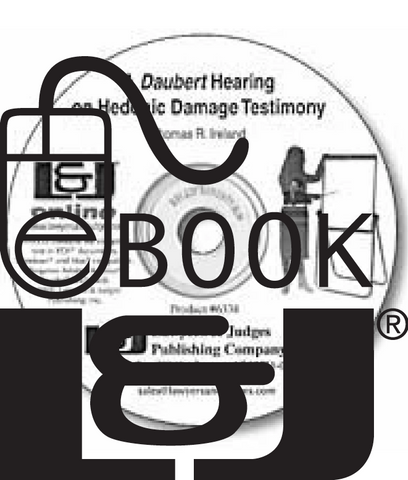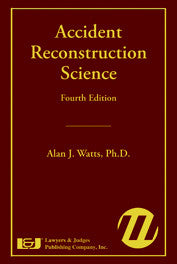
Forensic Biomechanics PDF eBook
- Author: Patrick Hannon, Kerry Knapp
- ISBN 10: 1-933264-52-7
- ISBN 13: 978-1-933264-52-3
- Copyright Date Ed: August 1, 2006
- Pages: 336 pages
- PDF eBook
This new reference explains the role of biomechanics, the study of the mechanics of the living body, and the forces acted upon it, in accident and injury cases. This book gives you an in-depth look at the area of human injury biomechanics. It also discusses the role of the biomechanist and when and how he or she can help with your investigation. The authors discuss biomechanical causation versus medical causation, the basic principles of biomechanics, approaches to the use of biomechanics in investigation, and application of biomechanical principles to impact injuries. They also provide detailed information on the biomechanics of the human body including bone tissue, articular cartilage, soft tissue, blood and fluids, spinal cord and nerve tissue, joints, and extremities.
This book contains over 300 diagrams and images. This book is invaluable if you are working on an accident or injury case, and need to understand the principles of the biomechanics behind the injury.
Topics Include:
- Overview of Biomechanics of Injury
- Basic Principles of Biomechanics
- Impacts
- Bone Tissue
- Soft Tissue and Bodily Fluids
- Articular Cartilage
- The Spinal Cord and Nerves
- The Head, Face, and Brain
- The Torso and Thorax
- The Cervical and Lumbar Spine
- Joints
- Extremities
Table of Contents
Chapter 1: Introduction
1.1 What Is Biomechanics and Injury Biomechanics?
1.2 Who Are Biomechanists? What Is Their Role?
A. Biomechanics: A scientific discipline
B. Biomechanical causation versus medical causation
1.3 How to Work with a Biomechanist: A Low Impact Example
1.4 When Can a Biomechanist Help?
1.5 Some Non-Automotive Examples
Chapter 2: The Analytical Approach
2.1 Introduction
2.2 Statement of Problem
2.3 Mental Models and Situation Awareness
2.4 The General Decision Tree Model
A. Application 1: The low-speed motor vehicle accident
B. Application 2: Gunshot death
Chapter 3: Basic Principles of Biomechanics
3.1 Introduction
3.2 Linear and Angular Movement
A. The anatomical position: Planes, axes, and movements
B. Vectors and scalars
3.3 Kinematics
A. Time
B. Position
C. Displacement
D. Linear and angular velocity
E. Linear and angular acceleration
F. Kinematic case examples
3.4 Kinetics
A. Characteristics of forces, moments, and torques
B. Classical mechanics
C. Special application of forces
3.5 Work and Energy
3.6 General Material Mechanics
A. Rigid body mechanics versus deformable solids
B. Material properties of biological materials
Chapter 4: The Application of Biomechanical Principles to Impacts
4.1 Introduction
4.2 Falls
A. The impulse equation approach
B. The energy equation approach
4.3 Vehicle Impacts
A. Automobile impacts
B. Watercraft impacts
C. Aircraft impacts
D. Bicycle and motorcycle impacts
4.4 Pedestrian Impacts
A. Fender vault trajectory
B. Roof vault trajectory
C. Wrap trajectory
D. Forward projection trajectory
E. Somersault trajectory
4.5 Seat Belt Restraint Use in Vehicles
4.6 Air Bags and Air Curtains
A. Front air bags
B. Side air bags
Chapter 5: Biomechanics of Bone Tissue
5.1 Bone Growth and Development
5.2 Function of Bones
5.3 Biological Properties of Bones
5.4 Material Properties of Compact and Cancellous Bone
5.5 Bone Anisotropy
5.6 Ductile and Brittle Properties of Bone
5.7 Bone Stiffness
5.8 Bone Viscoelasticity
5.9 Bone Fracture-Failure Behavior in Response to Loading
5.10 Direct and Indirect Loading
5.11 Combined Loading
5.12 Bone Geometry Affects Fracture Failure
5.13 Failure at the Epiphyseal Growth Plate
5.14 Other Fractures
5.15 Stress Risers and Open Section Defects
5.16 Bone Unloading
5.17 Chronic Loading Bone Failure
5.18 Degenerative Changes in Bone Caused by Aging
5.19 Fracture Fixation and Healing: Biomechanical Considerations
Chapter 6: Biomechanics of Articular Cartilage
6.1 Introduction
6.2 Articular Cartilage
A. Overview of the structure of articular cartilage
B. Articular cartilage components and material properties
6.3 Lubrication of Articular Cartilage Surfaces
6.4 Effect of Loads and Stresses
6.5 Deformable Bearings and Stress Relaxation
6.6 Biomechanicical Factors Involved in Articular Cartilage Degeneration
Chapter 7: Soft Tissue Biomechanics: Tendons, Ligaments, Muscle and Skin; Blood Fluid Dynamics
7.1 Introduction
7.2 Tendon and Ligament Development, Structure, and Physiology
A. Tendon and ligament tissue healing
B. Material properties of ligaments and tendons
7.3 Skeletal Muscle Development, Structure, and Physiology
A. Muscle tissue healing
B. Material properties of skeletal muscle tissue
7.4 Skin Development, Structure, and Physiology
A. Skin tissue healing
B. Material properties of skin tissue
7.5 Vasculature and Blood
A. Vasculature structure and material properties
B. Blood fluid dynamics
7.6 Anisotropic and Viscoelastic Behavior
A. Anisotropic behavior
B. Viscoelastic behavior
Chapter 8: Biomechanics of Spinal Cord, Nerve Roots, and Peripheral Nerve
8.1 Introduction
8.2 Anatomy of the Spinal Cord and Nerve Roots
8.3 Anatomy of Peripheral Nerve
8.4 Microanatomy and Physiology of Neuron Axons
8.5 Spinal Cord Loading
A. Penetration
B. Compression
C. Shear
8.6 Specific Spinal Cord Injuries
A. Anterior cord syndrome
B. Central cord syndrome
8.7 Nerve Root Loading—Tension, Compression, and Shear
8.8 Peripheral Nerve Loading
A. Tension
B. Compression
8.9 Peripheral Nerve Injury
A. Categories of peripheral nerve injury
B. Multiple levels of peripheral nerve compression
Chapter 9: Head, Face, and Brain
9.1 Introduction
9.2 Structural Anatomy of the Head
A. Scalp anatomy
B. Face and skull anatomy
C. Brain anatomy
9.3 Loading to Head, Face, and Brain
A. Scalp loading
B. Loading of the face and skull
C. Energy absorption during facial fracture
D. Classification of facial fractures
E. Other facial injuries
F. Skull and facial bone loading and brain injury
G. Infant skull and brain injury
H. Brain loading and traumatic brain injury (TBI)
9.4 Mechanisms of Traumatic Brain Injury
A. Penetration
B. Linear head acceleration: coup and contrecoup contusions
C. Angular head acceleration
D. Mild brain injury
9.5 Closing Comments––Brain Injury
9.6 Protection of the Skull, Face, and Brain
A. Helmet protection
B. Air bag protection in automobiles
C. Air bag benefits—reduction of risk to head link injury
Chapter 10: Torso and Thorax
10.1 Introduction
10.2 Classifying Injury Severity
10.3 Abdomen
10.4 Abdominal Anatomy and Mechanisms of Injury
A. Liver
B. Spleen
C. Kidneys
D. Adrenal glands
E. Pancreas
F. Stomach
G. Small intestine
H. Large intestine
I. Abdominal wall <brJ. Gall bladder
K. Urinary bladder
L. Reproductive organs
M. Major abdominal vessels
10.5 Biomechanics and Injury Tolerance of the Abdomen
10.6 Biomechanics and Injury Tolerance of the Male Reproductive System
A. Accident trauma loading
B. Loading to the perineum from bicycling activity
10.7 Thorax
10.8 Thorax Anatomy and Mechanisms of Injury
A. Ribs and sternum
B. Heart
C. Thoracic aorta
D. Thoracic vena cava (Inferior and Superior)
E. Trachea, bronchi and lungs
F. Diaphragm
10.9 Biomechanics and Injury Tolerance of the Thorax
10.10 Restraint Systems and Experimental
Chapter 11: Biomechanics of the Cervical Spine
11.1 Introduction
11.2 Structural and Functional Anatomy of the Cervical Spine
A. Bony elements
B. Intervertebral joints
C. The cervical spine intervertebral disk
D. Ligaments of the cervical spine
E. Neurovascular structures in the cervical region
F. Cervical spine musculature
11.3 Loading to the Cervical Spine Elements
A. Direct impact, crush, lacerations, and penetrations <brB. Indirect loading (forces, moments, and torques)
11.4 Cervical Spine Trauma
A. Bony elements
B. Soft tissues of the cervical spine
11.5 Tolerance Limits of Cervical Spine Tissues
A. Bone elements
B. Ligaments and joints
C. The cervical intervertebral disk
D. Muscle and tendon tissue
11.6 Cervical Spine–Sources of Pain
A. Bone tissue and pain
B. Joints—ligamentous and capsular pain
C. Discogenic pain
D. Muscle and myofascial pain
E. Neural structures of the cervical spine
Chapter 12: Lumbar Spine
12.1 Introduction
12.2 Structural and Functional Anatomy of the Lumbar Spine
A. Bony elements
B. Intervertebral joints
C. The lumbar intervertebral disk
D. Ligaments of the lumbar spine
E. Neurovascular structures of the lumbar region
F. Lumbar spine musculature
12.3 Loading to the Lumbar Spine Elements
A. Direct loading
B. Indirect loading
12.4 Lumbar Spine Trauma
A. Bony elements (fracture failure) and the intervertebral joints
B. Soft tissues of the lumbar spine
12.5 Lumbar Spine Tolerance Limits
A. Bony elements
B. Ligaments and joints
C. The intervertebral disk
D. Muscle and tendon tissue
E. Neural structures
12.6 Lumbar Spine Sources of Pain
A. Bony structures
B. Joints—ligamentous and capsular pain
C. The intervertebral disk
D. The lumbar intervertebral disk in asymptomatic people
E. Muscle tissue
F. Neural structures
Chapter 13: The Shoulder
13.1 Introduction
13.2 Anatomy of the Shoulder
13.3 Peripheral Nerve Injuries
13.4 Muscle Impingement Syndromes of the Shoulder
13.5 Dislocations and Subluxations of the Shoulder
13.6 Fractures of the Shoulder Complex
13.7 Fractures of the Humerus
Chapter 14: The Elbow
14.1 Introduction
14.2 Anatomy of the Elbow
14.3 Injuries
A. Repetitive use injuries
B. Throwing injuries
C. Other repetitive motion injuries
14.4 Indirect External Loading
14.5 Direct Impact Fractures
Chapter 15: The Wrist and Hand
15.1 Introduction
15.2 Anatomy of the Wrist
15.3 Anatomy of the Hand
15.4 Injuries of the Wrist
A. Fractures
B. Fractures and dislocations of the hand
Chapter 16: Anatomy of the Pelvis and Hip
16.1 Introduction
16.2 Anatomy of the Pelvis and Hip
16.3 Ligaments of the Hip
16.4 Muscles of the Hip Joint
16.5 Injuries of the Hip Joint
A. Dislocation
B. Labral tears
C. Hip pointers
D. Fractures
E. Avulsions
Chapter 17: The Knee
17.1 Introduction
17.2 Anatomy
A. Biomechanics
B. Kinematics
C. Passive stability
D. Injury
E. Medial ligament injuries
F. Lateral ligament injuries
G. Anterior cruciate ligament injuries <brH. Posterior cruciate ligament injuries
17.3 Classification of Ligament Injury in the Knee
17.4 Knee Dislocations (Definition/Literature Review)
17.5 Knee Dislocations and Obesity
17.6 Fractures
17.7 Conclusion
Chapter 18: The Foot and Ankle
18.1 Introduction
18.2 Anatomy
A. Bones of the foot
B. The ligaments of the ankle and foot
C. Muscles of the ankle and foot
18.3 Ankle Trauma
A. Sprains
B. Fractures
18.4 Injuries to the Foot
Appendix A: Anthropometric Measurements
Appendix B: Anatomical Mechanics—A Concept and Quantitative Approach: Bones, Joints, and Muscles
Appendix C: Conversion Factors
Appendix D: Instrumentation in Biomechanics
Appendix E: A Brief Summary of Neurophysiology and Muscle Activity




